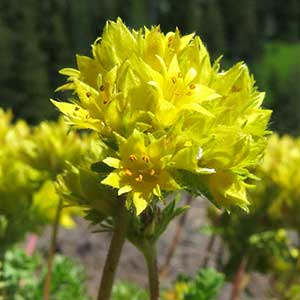Ivesia gordonii
Ivesia aperta
alpine ivesia, alpine mousetail, Gordon's ivesia
Sierra Valley ivesia, Sierra Valley mousetail
prostrate to erect, (0.2–)0.5–4 dm.
decumbent to erect, 1.5–4.5 dm.
tightly to loosely cylindric, (1–)3–20(–25) cm; sheathing base ± glandular abaxially, otherwise glabrous;
petiole 0.5–8 cm, hairs 0.2–0.5 mm;
leaflets (6–)10–25 per side, (1–)2–13(–18) mm, glabrous or ± hirsute or villous, glandular-puberulent or -pubescent, lobes (2–)4–8(–15), linear or narrowly oblanceolate to obovate, apex rarely setose.
(7–)10–20(–23) cm; sheathing base densely strigose abaxially;
stipules absent;
petiole 4–8 cm, hairs abundant, ascending, ± 1(–3) mm;
leaflets 20–35 per side, loosely overlapping, 3–15(–20) mm, lobes 0–4(–5), oblanceolate to elliptic, hairs abundant, ascending to appressed, ± 1(–2) mm.
1(–2), not paired.
3–8.
5–50(–70)-flowered, 1–8(–11) cm diam.;
glomerules 1–several.
(10–)20–250-flowered, 1–14 cm diam., flowers arranged in several to many tight glomerules of 5–20 flowers.
1–3(–5) mm.
1–3(–15) mm.
5–12 mm diam.;
epicalyx bractlets linear to narrowly elliptic, (0.5–)1–3.5(–4) mm;
hypanthium turbinate to campanulate, (1.5–)2–4(–4.5) × 2–4(–5) mm;
sepals (2–)2.5–5(–6) mm, obtuse to ± acute;
petals yellow, narrowly oblanceolate to narrowly spatulate, (1–)1.5–3 mm;
stamens 5, filaments 1.3–2.5 mm, anthers yellow, sometimes red-margined, 0.5–1 mm;
carpels (1–)2–4(–6), styles 2.5–4.5(–6) mm.
5–12 mm diam.;
epicalyx bractlets lanceolate, 1.5–2.5(–3.5) mm;
hypanthium cupulate, 1–2 × 2.5–4(–5) mm, 1/2–2/3 as deep as wide;
sepals green, 2.5–4(–5.5) mm, acute to acuminate;
petals light yellow, oblanceolate to broadly obovate, 2–7 mm;
stamens 20, filaments filiform, 1–4 mm, anthers yellow, 0.4–0.6 mm;
carpels 2–7, styles 2–4 mm.
grayish brown to mottled brown, ± 2 mm.
brown, 2–3 mm.
Ivesia gordonii
Ivesia aperta
Varieties 4 (4 in the flora).
Ivesia gordonii is the most widespread species of the genus, occurring from Washington to Montana, south to central California and Colorado. The species can be distinguished from other members of sect. Ivesia by the relatively deep hypanthium, which is about as deep as wide. Four varieties are provisionally recognized here (B. Ertter and J. L. Reveal 2007), with the likelihood that future work may indicate additional and/or alternate circumscriptions. Populations that are difficult to assign to a variety can be found where the recognizable taxonomic units come together, for example, in northeastern Utah and western Wyoming, involving var. gordonii and var. wasatchensis, and in California and central Idaho where var. alpicola and var. ursinorum tend to merge.
(Discussion copyrighted by Flora of North America; reprinted with permission.)
Varieties 2 (2 in the flora).
Many historic collections of Ivesia aperta were identified as I. pickeringii. D. D. Keck (1938) considered I. aperta to be no more than a yellow-flowered form of I. sericoleuca, a situation clarified and rectified by J. T. Howell (1962). The ranges of the two species overlap in Sierra Valley, California, with mixed populations occurring near Beckwourth and in the valleys north of Sierra Valley. In general, var. aperta occurs in the southeastern portions of the valley and I. sericoleuca occurs on the western side; the species are not otherwise sympatric. In addition to petal color, which fades in herbarium material, I. aperta differs from I. sericoleuca in having smaller flowers with shallower hypanthia. Hairs at the base of the stems and petioles of I. aperta are relatively short (to 2 mm) and generally ascending; those of I. sericoleuca are longer (to 4 mm) and spreading. Variety canina combines the petal color of var. aperta and floral dimensions of I. sericoleuca.
(Discussion copyrighted by Flora of North America; reprinted with permission.)
1. Leaflets 7–13(–18) mm, glabrous or sparsely hirsute or villous marginally; stems (1–)1.5–4 dm; inflorescences usually branched, 2–8(–11) cm diam., glomerules (1–)2–6(–10), ± capitate. | var. wasatchensis |
1. Leaflets (1–)2–7(–9) mm, hairy or ± glabrous except marginally ciliate; stems (0.2–)0.5–2.5 dm; inflorescences simple or branched, 1–3(–5) cm diam., glomerules 1(–3), ± capitate to loosely congested | → 2 |
2. Stems usually prostrate to ascending, rarely nearly erect, usually dark reddish, minutely glandular or glandular-puberulent to -pubescent; leaves to 0.8 cm diam.; anthers usually red-margined. | var. ursinorum |
2. Stems usually ascending to erect, sometimes decumbent, usually greenish, rarely reddish, hirsute to villous, glandular-puberulent to -pubescent; leaves to 1.5 cm diam.; anthers rarely red-margined | → 3 |
3. Stems usually hirsute to villous, sometimes densely so, glandular-pubescent or eglandular; basal leaves (3–)5–10(–15) cm; flowers 7–12 mm diam.; e Idaho and w Montana to Utah, Wyoming, and w Colorado. | var. gordonii |
3. Stems not or sparsely hirsute to villous, glandular-puberulent or -pubescent; basal leaves 2–8(–10) cm; flowers 5–9 mm diam.; s Washington to California and e to w Montana. | var. alpicola |
1. Petals 2–3 mm, oblanceolate; filaments 1–1.5(–2) mm; Sierra Valley drainage, California, Carson and Virginia ranges, Nevada. | var. aperta |
1. Petals usually 4–7 mm, narrowly to broadly obovate; filaments 2–4 mm; Dog Valley, California, Nevada. | var. canina |


